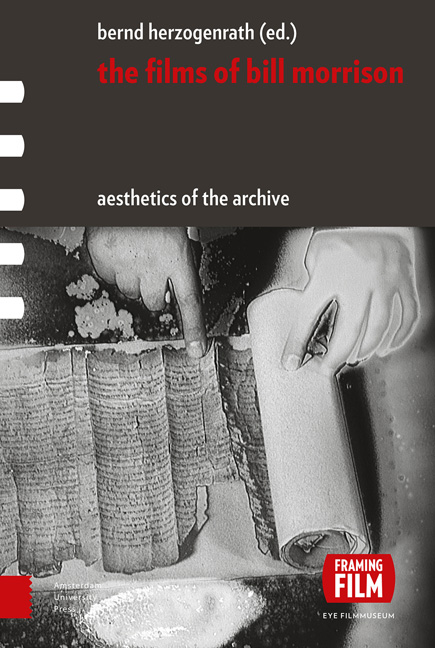Book contents
- Frontmatter
- Contents
- Acknowledgments
- Aesthetics of the Archive: An Introduction
- Chapter 1 Drafts and Fragments: Reflections around Bill Morrison and the Paper Print Collection
- Chapter 2 The Film of Her: The Cine-Poet Laureate of Orphan Films
- Chapter 3 Ghost Trip: Searching for Potential Myths
- Chapter 4 Decasia: The Matter | Image: Film is also a Thing
- Chapter 5 The Mesmerist: Illustrating the Return of the Repressed
- Chapter 6 Light is Calling: Celluloid Dreams
- Chapter 7 Gotham: Zoetrope: Block by Block
- Chapter 8 Outerborough: Early Cinema Revisited
- Chapter 9 The Highwater Trilogy: Thinking the Liquid – On the Ethics of Water and the Material Ecologies of Disaster and Ruination
- Chapter 10 Porch: Archives, Collective Memory, and the Poetics of Home Movies
- Chapter 11 The Future Lasts Long: The Romanov Lost Family Archives
- Chapter 12 Who by Water: Variations on Matter, Figures, Memory, and Mythology
- Chapter 13 Every Stop on the F-Train: Beyond and within the Restless Netherworld of (Manhattan’s) Mind
- Chapter 14 Spark of Being: Bachelor Machine
- Chapter 15 The Miners’ Hymns: Acts of Resurrection
- Chapter 16 Tributes – Pulse: A Requiem for the 20th Century: Death | Drive | Image
- Chapter 17 Just Ancient Loops: The Loops of Life in Intonation
- Chapter 18 The Great Flood: Water is Transparence Derived from the Presence of Everything
- Chapter 19 Re-Awakenings: Bill Morrison in Conversation
- Index of Film Titles
- Index of Names
- Index of Subjects
- Already Published
Chapter 10 - Porch: Archives, Collective Memory, and the Poetics of Home Movies
Published online by Cambridge University Press: 12 December 2020
- Frontmatter
- Contents
- Acknowledgments
- Aesthetics of the Archive: An Introduction
- Chapter 1 Drafts and Fragments: Reflections around Bill Morrison and the Paper Print Collection
- Chapter 2 The Film of Her: The Cine-Poet Laureate of Orphan Films
- Chapter 3 Ghost Trip: Searching for Potential Myths
- Chapter 4 Decasia: The Matter | Image: Film is also a Thing
- Chapter 5 The Mesmerist: Illustrating the Return of the Repressed
- Chapter 6 Light is Calling: Celluloid Dreams
- Chapter 7 Gotham: Zoetrope: Block by Block
- Chapter 8 Outerborough: Early Cinema Revisited
- Chapter 9 The Highwater Trilogy: Thinking the Liquid – On the Ethics of Water and the Material Ecologies of Disaster and Ruination
- Chapter 10 Porch: Archives, Collective Memory, and the Poetics of Home Movies
- Chapter 11 The Future Lasts Long: The Romanov Lost Family Archives
- Chapter 12 Who by Water: Variations on Matter, Figures, Memory, and Mythology
- Chapter 13 Every Stop on the F-Train: Beyond and within the Restless Netherworld of (Manhattan’s) Mind
- Chapter 14 Spark of Being: Bachelor Machine
- Chapter 15 The Miners’ Hymns: Acts of Resurrection
- Chapter 16 Tributes – Pulse: A Requiem for the 20th Century: Death | Drive | Image
- Chapter 17 Just Ancient Loops: The Loops of Life in Intonation
- Chapter 18 The Great Flood: Water is Transparence Derived from the Presence of Everything
- Chapter 19 Re-Awakenings: Bill Morrison in Conversation
- Index of Film Titles
- Index of Names
- Index of Subjects
- Already Published
Summary
ABSTRACT
Porch is a poetic short film combining 8mm home movie footage with Julia Wolfe's haunting minimalist score in an exploration of the changing shape of the American home. Porch is Morrison's only film comprised entirely of archival home-movie footage, a subgenre of found-footage filmmaking with rapidly developing theory and criticism. The impact of the evolving concept of collective memory on archival practice is considered as it relates to the appropriation of home movies into new films. Porch exemplifies the artistic possibilities for artistic and institutional collaboration in constructing representations of collective memory using home movies as a common language.
KEYWORDS
opera, shelter, collective memory, home movies
Summer evenings and lemonade
A time when the whole town knew each other and said ‘hello’
First came screens against the bugs
Then came glass against the chill
Then came walls against the winter
The street became so loud with cars and trucks Passersby diminished
Inside there is air-conditioning and TV
– Porch, libretto by Deborah ArtmanBill Morrison's short film Porch originated as a component of the visual accompaniment to the staged oratorio Shelter, the third in a trilogy of collaborative works by composers Michael Gordon, David Lang, and Julia Wolfe. The libretto for Shelter was written by Deborah Artman and the movement entitled Porch was composed by Julia Wolfe. Co-commissioned by The Next Wave Festival of the Brooklyn Academy of Music, musikFabrik, and Kunstiftung NRW, the production was first performed under the direction of Ridge Theater's Bob McGrath and conductor Brad Lubman. The initial conception of the piece centered around the idea of human shelter, both literal and metaphorical. The collaborators set out to explore the various meanings and connotations of the word, from basic protection from the elements to the building of an American home (Bang on a Can). Following a process of development, during which Morrison created a series of films in his signature found-footage style to integrate with Laurie Olinder's projection design, Shelter premiered in Cologne, Germany on 20 March 2005 (Ensemble musikFabrik). Variations of the production continue to be presented around the world, most recently in Los Angeles on 31 May 2015 (Los Angeles Philharmonic Association).
- Type
- Chapter
- Information
- The Films of Bill MorrisonAesthetics of the Archive, pp. 167 - 176Publisher: Amsterdam University PressPrint publication year: 2017



